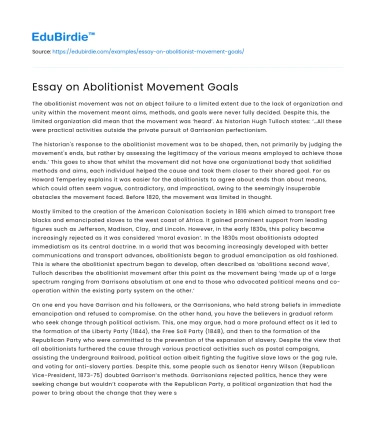The abolitionist movement was not an abject failure to a limited extent due to the lack of organization and unity within the movement meant aims, methods, and goals were never fully decided. Despite this, the limited organization did mean that the movement was ‘heard’. As historian Hugh Tulloch states: ‘…All these were practical activities outside the private pursuit of Garrisonian perfectionism.
The historian's response to the abolitionist movement was to be shaped, then, not primarily by judging the movement's ends, but rather by assessing the legitimacy of the various means employed to achieve those ends.’ This goes to show that whilst the movement did not have one organizational body that solidified methods and aims, each individual helped the cause and took them closer to their shared goal. For as Howard Temperley explains it was easier for the abolitionists to agree about ends than about means, which could often seem vague, contradictory, and impractical, owing to the seemingly insuperable obstacles the movement faced. Before 1820, the movement was limited in thought.
Save your time!
We can take care of your essay
- Proper editing and formatting
- Free revision, title page, and bibliography
- Flexible prices and money-back guarantee
Mostly limited to the creation of the American Colonisation Society in 1816 which aimed to transport free blacks and emancipated slaves to the west coast of Africa. It gained prominent support from leading figures such as Jefferson, Madison, Clay, and Lincoln. However, in the early 1830s, this policy became increasingly rejected as it was considered ‘moral evasion’. In the 1830s most abolitionists adopted immediatism as its central doctrine. In a world that was becoming increasingly developed with better communications and transport advances, abolitionists began to gradual emancipation as old fashioned. This is where the abolitionist spectrum began to develop, often described as ‘abolitions second wave’, Tulloch describes the abolitionist movement after this point as the movement being ‘made up of a large spectrum ranging from Garrisons absolutism at one end to those who advocated political means and co-operation within the existing party system on the other.’
On one end you have Garrison and his followers, or the Garrisonians, who held strong beliefs in immediate emancipation and refused to compromise. On the other hand, you have the believers in gradual reform who seek change through political activism. This, one may argue, had a more profound effect as it led to the formation of the Liberty Party (1844), the Free Soil Party (1848), and then to the formation of the Republican Party who were committed to the prevention of the expansion of slavery. Despite the view that all abolitionists furthered the cause through various practical activities such as postal campaigns, assisting the Underground Railroad, political action albeit fighting the fugitive slave laws or the gag rule, and voting for anti-slavery parties. Despite this, some people such as Senator Henry Wilson (Republican Vice-President, 1873-75) doubted Garrison’s methods. Garrisonians rejected politics, hence they were seeking change but wouldn’t cooperate with the Republican Party, a political organization that had the power to bring about the change that they were seeking. Additionally, they preached ‘moral suasion’ yet rejected the church. Therefore, Garrison marginalized his cause by going against the common patriotism, partisanship, and religious sentiments of the majority of his countrymen in the North.






 Stuck on your essay?
Stuck on your essay?

